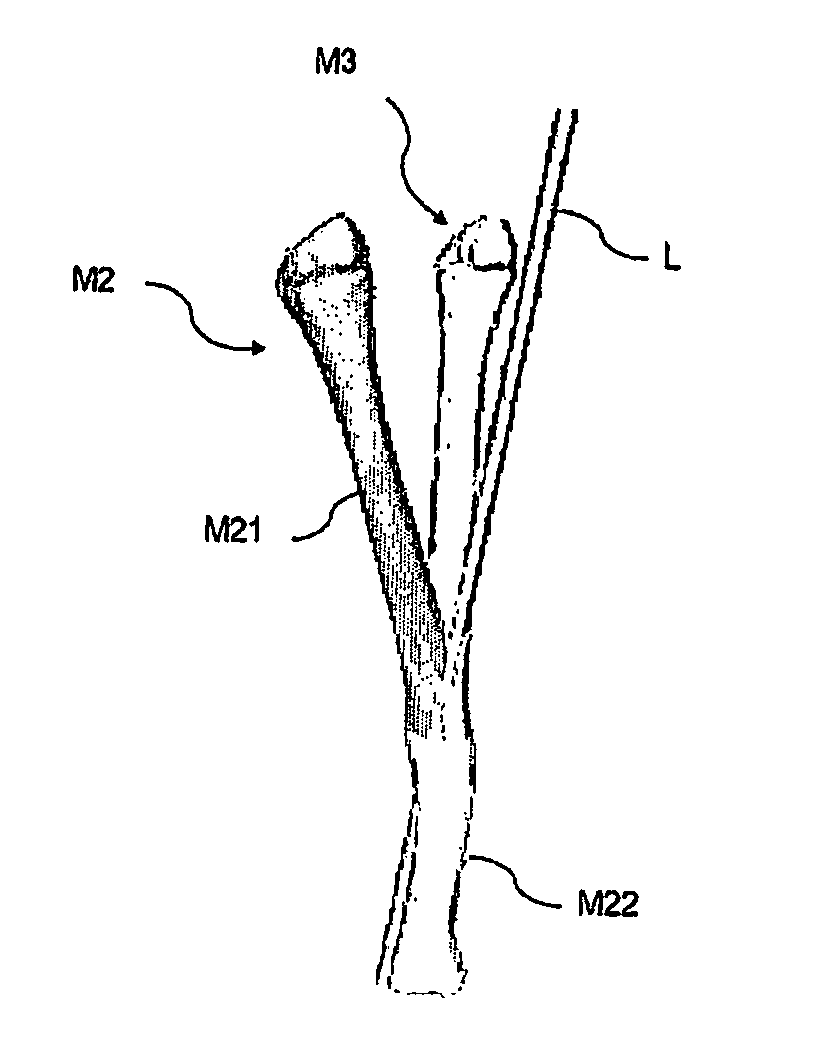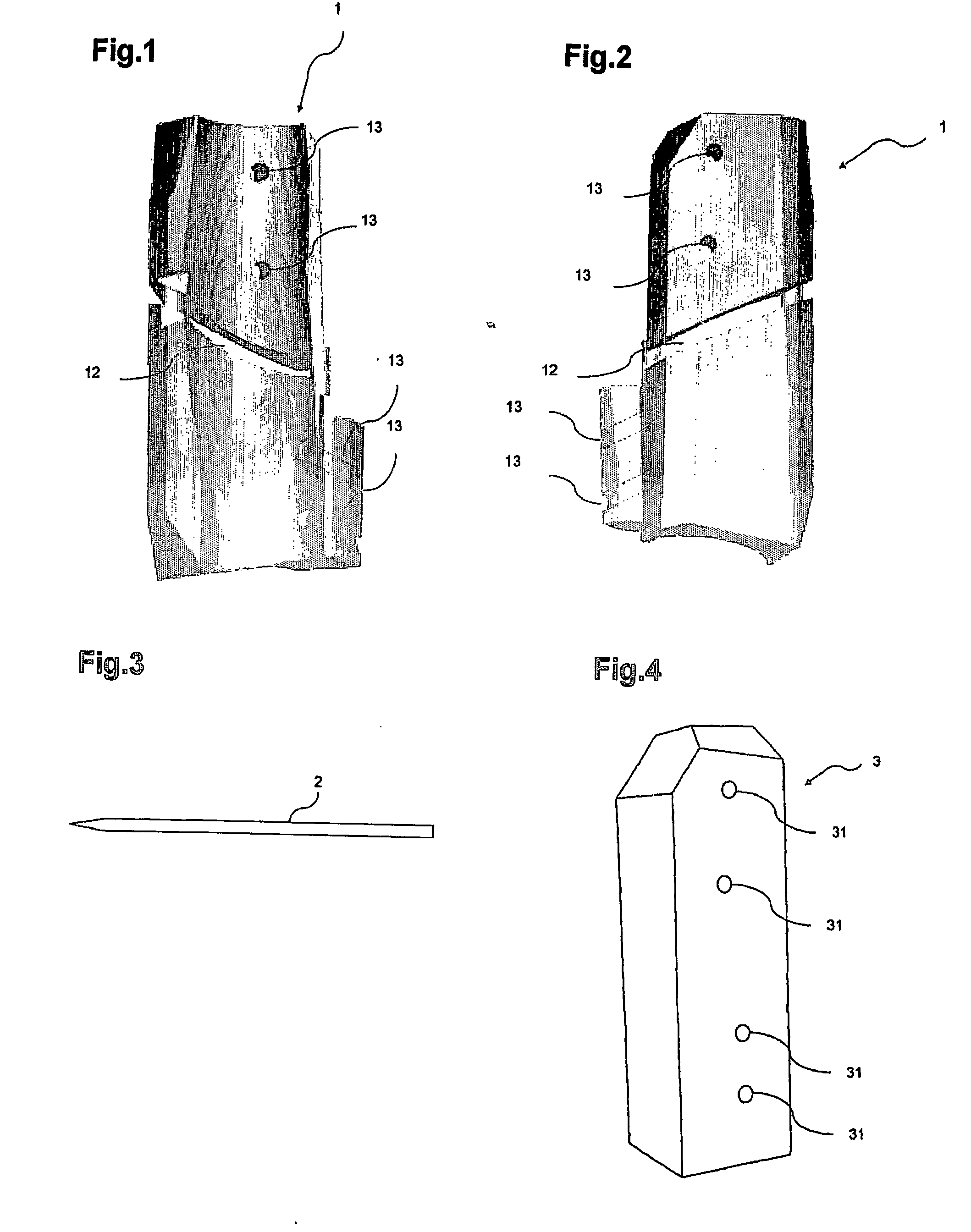Method, members, system and program for bone correction
a technology for osteotomy and assisting members, applied in the field of osteotomy assisting members, can solve the problems of insufficient correction, many defects in actual surgical operations, and difficulty in accurately simulating three-dimensional correction osteotomy surgical operations, and achieve the effect of accurate and easy correction of deformed bones
- Summary
- Abstract
- Description
- Claims
- Application Information
AI Technical Summary
Benefits of technology
Problems solved by technology
Method used
Image
Examples
example 1
Production of Template Assisting Members and Application Thereof
[0457] In this example, template assisting members were produced after performing a preoperative simulation (FIG. 21) using actual deformed bones as a model. In the case of a fracture malunion on the forearm, the degree of deformity of the radius and the ulna is one of the main factors of restriction of pronation and supination. Pronation refers to rotating the forearm such that the palm is directed downward, and the supination refers to rotating the forearm such that the palm is directed upward (such that the palm is to receive something). It is desirable to correct the deformity as accurately as possible. The present inventor performed accurate correction osteotomy through a preoperative simulation using CR or MRI three-dimensional images. The methods and results will be described below.
[0458] There were 6 cases, and the patients were all male in the age range of 12 to 31 years with the average age of 19.2 years. Th...
example 2
8-Year-Old Male Child; Closed Wedge Osteotomy for Supracondylar Fracture of the Humerus
[0464] In this example, it will be demonstrated that the closed wedge osteotomy is applicable to the present invention. A surgical operation was performed by the method according to the present invention on an 8-year-old male patient having a supracondylar fracture of the humerus, which is a representative fracture around the elbow joint of children. This case is known as easily resulting in cubitus varus. FIG. 27 shows x-rays illustrating the affected site (the left x-ray shows a front view, and the right x-ray shows a side view thereof).
[0465]FIG. 28 shows the progress of hyper-extension in the cast caused by the initial treatment. It is shown that dorsiflexion occurs since no appropriate treatment was performed.
[0466]FIG. 29 shows the state of this patient 2 years after the initial treatment. It is shown that varus deformity and hyper-extension is left and natural correction is not sufficien...
example 3
21-Year-Old Male; Open Wedge Osteotomy for a Left Forearm Fracture Malunion
[0478] In this example, it will be demonstrated that open wedge osteotomy is applicable to the present invention. As an example, a case of a 21-year-old male patient with a left forearm fracture malunion was used. This patient showed an excessive deformity of the radius (FIG. 43). An forearm fracture is often seen among men in early youth to youth, and is considered to often cause a malunion when treated in a cast.
[0479] As shown in FIG. 44, this patient complained of a deformity and restriction of supination of forearm (i.e., such that the palm is to receive something). The supination was restricted to about 40 degrees (normally, 80 to 90 degrees).
[0480] It was found by computer simulation that the deformed bone was matched to the healthy bone by rotating the bone at 30 degrees about the screw axis (FIG. 45). A template was designed based on this information. It was found that by subtracting the bone and ...
PUM
 Login to View More
Login to View More Abstract
Description
Claims
Application Information
 Login to View More
Login to View More - R&D
- Intellectual Property
- Life Sciences
- Materials
- Tech Scout
- Unparalleled Data Quality
- Higher Quality Content
- 60% Fewer Hallucinations
Browse by: Latest US Patents, China's latest patents, Technical Efficacy Thesaurus, Application Domain, Technology Topic, Popular Technical Reports.
© 2025 PatSnap. All rights reserved.Legal|Privacy policy|Modern Slavery Act Transparency Statement|Sitemap|About US| Contact US: help@patsnap.com



